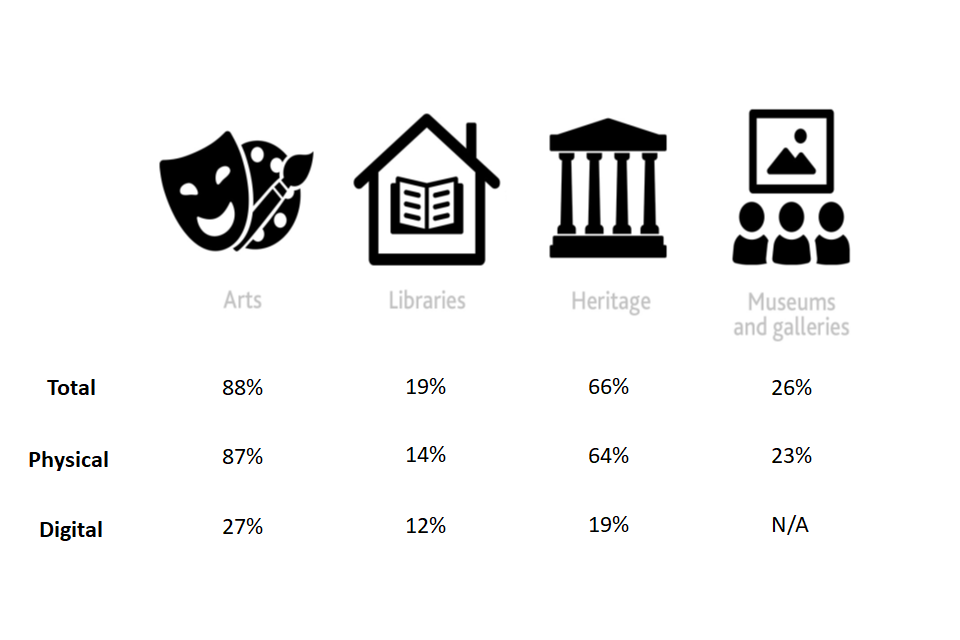Participation Survey October to December 2021: Key Findings
Updated 13 February 2025
Applies to England
13 February 2025 - A small number of figures have had revisions due to a minor processing error. The data tables in the October to December 2022 release (including October to December 2021) have been updated.
The October to December 2021 report has not been updated with these revisions. Please use the revised October to December 2021 data tables published as part of the October to December 2022 data tables for the latest estimates.
30 November 2023 - We have updated our breakdowns by disability status in the 2021/22 annual data tables to align with the Government Statistical Service harmonised standard. For further information, please see the update on the Participation Survey website.
The 2021/22 annual report has not been updated, and therefore please use the revised 2021/22 annual data tables, 2022/23 annual data tables and 2022/23 annual report for the latest disability estimates.
1. Key Findings
This section summarises the key findings from the Participation Survey. More detail follows in subsequent chapters. During the period October to December 2021, a representative sample of adults in England were asked about their engagement with a number of DCMS sectors during the previous 12 months; therefore, many survey questions cover participation stretching from October 2020 to December 2021, depending on when the respondent participated in the survey. Where questions do not cover the previous 12 months (for example live sport), this is stated in the relevant parts of the report and tables.
1.1 Culture
The graphic below shows the percentage of respondents who engaged physically (in person), digitally (online) and in total (either physical, digital or – for libraries – other) in the different cultural areas covered by the survey (arts, libraries, heritage and museums & galleries).

Figure 1.1: Cultural engagement (Arts, Libraries, Heritage and Museum & Galleries) in the previous 12 months, England: October to December 2021
- “I’m not interested”, “Due to COVID-19 restrictions or concerns” and “No reason in particular” were the most common barriers to engaging with (most common reasons given for not engaging with) cultural sectors.
1.2 Tourism
- Over half (55%) of adults took a holiday somewhere in England in the previous 12 months. Of these:
- Over two in five (44%) spent 3-6 nights away.
- 43% of adults said that they visited museums, galleries, heritage or cultural sites or events while they were away.
- Adults aged 75 and over, those living in London, adults with a long-standing limiting illness or disability, belonging to a non-White ethnic group, social housing dwellers, and those living in the most deprived deciles were less likely to take a holiday in England in the last 12 months.
1.3 Digital
- Internet use was high across the board, 93% of respondents use it. Of these, there was a high proportion of adults who personally owned and used devices at home, including:
- 94% owned and used a WiFi router or internet hub
- 90% owned and used a Smartphone
- 61% owned and used a laptop computer
- A fifth (20%) of respondents have taken part in digital or online skills training.
- Nearly a third (32%) of respondents said they would be interested in doing digital or online training, although the majority said only if they did not have to pay for it.
- A fifth (20%) of respondents said that they would not be interested in doing any digital or online skills training because they prefer to upskill themselves
- Over two thirds of respondents thought it was either very or fairly important to continue to develop digital or online skills
- Awareness of 5G was strong. 71% of respondents understood what it is (37% were interested in getting it in the near future, 34% were not), whilst 7% had not heard of it.
1.4 Major events
- Awareness of selected DCMS major events varied from 4% for UNBOXED: Creativity in the UK to 61% for Her Majesty the Queen’s Platinum Jubilee.
| Her Majesty the Queen’s Platinum Jubilee | UNBOXED: Creativity in the UK | Birmingham Commonwealth Games 2022 | Coventry City of Culture | |
| Awareness | 61% | 4% | 39% | 22% |
-
Of those that were aware of the events, interest in participation ranged from 50% for Coventry City of Culture to 81% for Her Majesty the Queen’s Platinum Jubilee. These respondents predominantly expressed interest in following events on radio and TV (including watching the event or news about the event), following events on social media, and/or participating in local events
-
Demographic breakdowns were variable. However, there was higher awareness of the events in Birmingham and Coventry from adults within the relevant region where those events are taking place (the West Midlands – 69% and 45% respectively).
-
Over three quarters of adults (76%) in England felt that they very or fairly strongly belonged to the United Kingdom.
1.5 Live sports
-
17% of adults watched live sport in person in the previous six months.
-
Of those sports, football was the most watched (63%), followed by other (19%) and rugby (14%).
-
Attendance at live sports in person was highest for men and adults without a long-standing illness or disability.
